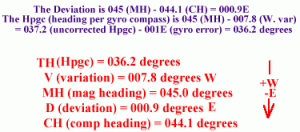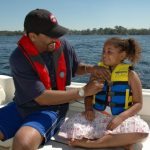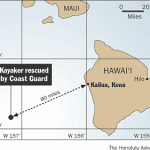One ocean covers more of the earth’s surface than all the earth’s entire LAND area. What is that ocean, and what percentage (within .5%) of the earth’s
surface does it cover?
Answer: The Pacific Ocean. It’s surface covers 32.4% of the earth…3.2% more than all land areas combined.
What is a nautical ‘camel’?
Answer: A float used as a fender, sometimes called a “breasting float”, OR a float used to raise sunken structures.
Name three circumstances where a sailing craft does not necessarily have the “right-of-way” over a powerboat.
Answer:
When under mechanical power
When overtaking
When in a narrow channel with limited maneuverability
When instructed in a Traffic Separation area or by local rule
Certain vessels engaged in fishing
Other vessel “not in command”
When risk of collision is likely (Rule of Prudent Seamanship)
A widely recognized substitute for Halon is the chemical FE 241. Within 5%, how much more FE 241 does it take to dispense the same firefighting effectiveness as Halon in a specific installation?
Answer: 70% more
By 1876, the Thomson Dry Card Compass was in wide use. What material was used to suspend the pairs of magnets from the compass card?
Answer: Silk Threads
From fore to aft, what are the names given to each of the masts of a five-masted schooner?
Answer: fore, main, mizzen, jigger, spanker
or: fore, main, middle, mizzen, jigger
or: fore, foremain, main, mizzen, jigger
Using the relationship of 2,000 yards to one nautical mile, what error is introduced for a distance of 3.4 nm?
Answer: 86.26 yards (6,076.12 feet in a nm /3 = 2,025.37 yards, minus 2,000 yards = 25.37 yards error per nm. 25.37 x 3.4 nm = 86.26 yards.)
What’s a shipboard “henway”?
Answer: About the same as she does ashore!
What is the basic construction and use of a “beam compass”?
Answer: A plotting instrument with the two legs attached to a bar of metal or wood instead of being hinged.
What is an ‘ash breeze’?
Answer: No breeze or wind…calm (A condition which necessitated breaking out the oars which were traditionally constructed of ashwood.)
What is the 7/10ths rule of Navigation?
Answer: A rule of thumb which states that the approximate distance to an object broad on the beam is equal to 7/10ths of the distance travelled by a craft
when the relative bearing changes from 22.5 degrees to 45 degrees, or from 135 degrees to 157.5 degrees, neglecting wind and/or current.
If the scale representation on a chart is shown as 1:437,480, how many nautical miles would you travel by moving one inch across the chart?
Answer: 6 nm – (437,480 divided by the number of inches in a nautical mile, 72,913.39)
What is a gnomon?
Answer: Any object the shadow of which serves as an indicator; as the shadow pin on a sun compass.
According to the Inland Navigation Rules, any vessel 12 meters or more in length must carry onboard a copy of the _______________ .
Answer: Inland Navigation Rules
Under the lateral system, what is the flashing time interval for “Flashing Lights” versus “Quick Flashing Lights”?
Answer: Flashing is not more than 30 times per minute, and Quick Flashing is not less than 60 times per minute.
While cruising in your powerboat, you notice that your speed has decreased, the stern has settled more into the water, and your rudder is sluggish. What is most likely the problem?
Answer: Shallow Water
During typhoon IDA in September, 1958, a dropsonde recorded the lowest sea-level barometric pressure ever recorded on earth, 750 miles east of Luzon. What was that pressure, in millibars?
Answer: 877.0 millibars
An important lunar cycle is called the NODAL PERIOD. How long is this cycle?
Answer: 18.6 years
What is the more popular name for the Ratline Hitch?
Answer: The Clove Hitch
A vessel is being maneuvered to determine the residual deviation of a magnetic compass. The gyrocompass, which has an error of 1 degree E., is used for
placing the vessel on the magnetic heading of 045 degrees. Variation in the area is 7.8 degrees W. The compass heading is 044.1. What is the deviation at MH 045?
Answer: .9 degree E. (see below)






